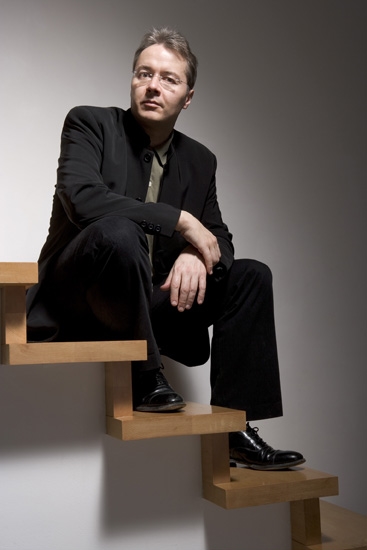Asbury leads New World in rewarding program of English music

Stefan Asbury conducted the New World Symphony in 20th- and 21st-century English music Saturday night.
Great Britain shed its reputation as a backwater for classical music composition more than a century ago.
Today, the land of Elgar and Britten remains a center for the production of new music, and the works of two of that country’s living composers–as well as one dead one—were on display Saturday in Miami Beach with the New World Symphony.
The concert at New World Center saw the United States premiere of the young composer Helen Grime’s A Cold Spring, a performance of Thomas Adès’ 2005 Violin Concerto and an attempt to revive the thorny, complex Symphony No. 4 by Michael Tippett, a once widely played composer whose works have quickly faded from the repertoire since his death in 1998.
New World’s conducting fellow Christian Reif, who is about to leave for a job as resident conductor of the San Francisco Symphony, led the performance of Grime’s A Cold Spring, a 2009 work for small orchestra, with the young composer in the audience.
Inspired by a poem by Elizabeth Bishop, the work effectively communicated a sense of awakening. Restless ascending passages in the strings were leavened by pensive tones in the oboe. A long horn solo, skillfully performed by Anthony Delivanis, skipped in a disjunctive manner that suggested animals springing into motion after the cold of winter. A passage that began as a rumbling in the double bass quickly gained strength as the other players joined in – all communicating a sense of spring that was more dramatic than pastoral.
The British conductor Stefan Asbury led the rest of the concert. It’s usually an ominous sign when the conductor walks on stage and reaches for a microphone rather than a baton. But Asbury felt a few words were in order before the performance of the Tippett symphony.
As a young music student in London, he said, he remembers attended Tippett premieres at Covent Garden. But unlike the music of his contemporary, Benjamin Britten, Tippett’s music has ceased to be performed, he said, and when Asbury was invited to conduct New World, he said he was “quite insistent” that the concert include something by Tippett. With this performance, he said, he was doing what he could to restore the Symphony No. 4 to the repertoire.
If anything could make the case for the work, it was this performance. Asbury’s conducting gave the long, one-movement work an overriding sense of structure, as he calibrated volume and intensity, with portentous rests and passages of cool repose that contrasted with the overall tone of swirling darkness.
The work is full of brilliant, imaginative passages–counterpoint that starts in the upper or lower strings and then spreads outward, rapid passages in marimba and xylophone that gave a tangy texture to the surrounding sounds, an emphasis on cellos and basses that helped give the symphony a uniquely menacing tone. The ending was striking–wild passages in strings alternating with a solemn brass choir as electronic sounds of breathing gave the impression of someone drawing their last breath.
Although at more than a half hour, the symphony seemed long for its rarely varying tone of grim tension. Yet it had undeniable power, and Asbury deserves our gratitude for bringing it to South Florida.
The Tippett symphony may be a hard sell to audiences, while the Violin Concerto of Thomas Adès has been quickly taken into the repertoire, with regular performances and three recordings. With its racy virtuosity, instantly striking passages, unique tonal combinations and undeniable drama, it’s not hard to see why this work has become so immediately popular.

Anthony Marwood
Performing the concerto was the violinist Anthony Marwood, for whom it was written and who performed its world premiere. Like many contemporary violin concertos, the work barely gives the soloist a moment’s rest. Marwood plunged into the virtuosic first movement–an embroidery of rapid arpeggios and almost impossibly high passages–with a hard-driving, fearless momentum that he kept up to the end.
The heart of the concerto is the long, solemn slow movement. With its rolling chords in the violin, it has a stately Baroque grandeur, although one that passes through a landscape blasted by dissonant chords in the brass. The rumbles and growls in horns, trombone and tuba against the tone of the violin gave a unique character to the movement.
Although Marwood’s mastery of the concerto was apparent throughout, this was not an effortless performance and the clear force he applied to the violin added to the movement’s effectiveness. As the violin part grew in complexity and intensity, he brought the movement to a stirring climax as he strained successfully to project notes at the upper limit of the instrument’s range against the power of the brass instruments. He tossed off the last movement—which sounded something like the Sibelius Violin Concerto in its busy drive–with a light, sure touch.
Posted in Uncategorized
Leave a Comment
Sun Mar 27, 2016
at 1:25 pm
No Comments






